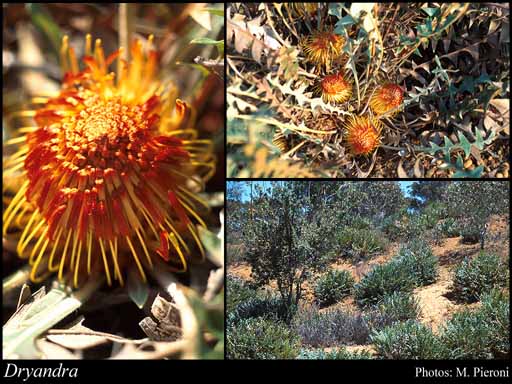This name is not current. Find out more information on related names.
- Reference
- Trans.Linn.Soc.London,Bot. 10:211, Tab. 3 (1810)
- Name Status
- Not Current

Scientific Description
Common name. Dryandras. Family Proteaceae.
Habit and leaf form. Small trees, or shrubs; evergreen. Mesophytic, or xerophytic. Heterophyllous, or not heterophyllous. Leaves small to medium-sized; alternate; usually spiral; leathery; petiolate, or subsessile, or sessile; non-sheathing; edgewise to the stem, or with ‘normal’ orientation; simple, or compound; epulvinate; pinnate, or bipinnate (partially). Leaf blades isobilateral (lower surface with a prominent midrib; upper surface usually smooth with a central furrow); dissected (almost to the midrib into lobes), or entire; flat, or solid; elliptic, or obovate, or obtriangular; when simple/dissected pinnatifid, or palmately lobed, or much-divided. Leaves without stipules. Leaf blade margins entire, or serrate, or dentate (to prickly-toothed). Leaves without a persistent basal meristem. Leaf anatomy. Hairs present, or absent. Stem anatomy. Secondary thickening developing from a conventional cambial ring.
Reproductive type, pollination. Fertile flowers hermaphrodite. Unisexual flowers absent. Plants hermaphrodite. Entomophilous, or ornithophilous, or pollinated by unusual means (by small marsupials).
Inflorescence and flower features. Flowers aggregated in ‘inflorescences’; in pairs, subtended by a common bract (the bract hairy or woolly); dense cones or in heads (on flat receptacles). The terminal inflorescence unit racemose (or two flowered). Inflorescences terminal (or lateral); bracteate heads, spikes or racemes; flower heads may be borne at ground level; with involucral bracts. Involucral bracts persistent. Involucral bracts prominent (bracts closely surrounded by leaves). Inflorescences pseudanthial, or not pseudanthial. The fruiting inflorescence conelike, or not conelike. Flowers sessile; bracteate; small to large (often very showy); regular, or somewhat irregular; when irregular, zygomorphic. The floral asymmetry when present, involving the perianth and involving the androecium. Flowers 4 merous; cyclic; tetracyclic, or tricyclic. Floral receptacle developing a gynophore, or with neither androphore nor gynophore. Free hypanthium absent. Hypogynous disk present; extrastaminal; of separate members (four narrow, membranous scales, usually accompanied by a few long hairs). Perianth of ‘tepals’; 4; 1 -whorled; free (with a linear claw and much narrower limb); cream, or yellow (usually). Androecium 4. Androecial members adnate; all equal, or markedly unequal; free of one another; 1 -whorled. Stamens 4; isomerous with the perianth; with sessile anthers. Anthers cohering, or connivent, or separate from one another; more or less basifixed; non-versatile; dehiscing via longitudinal slits; introrse; four locular; tetrasporangiate; appendaged (? via the elongated connective), or unappendaged. Gynoecium 1 carpelled. The pistil 1 celled. Gynoecium monomerous; of one carpel; superior. Carpel fully closed, or incompletely closed; stylate; apically stigmatic; 2 ovuled. Placentation marginal (? mostly), or apical. Ovary sessile. Ovules funicled, or sessile; non-arillate; orthotropous, or anatropous, or amphitropous, or hemianatropous.
Fruit and seed features. Fruit non-fleshy. The fruiting carpel dehiscent, or indehiscent; a follicle. Follicles septate (septum single or double). Gynoecia of adjoining flowers combining to form a multiple fruit, or not forming a multiple fruit. The multiple fruits coalescing, or not coalescing. Fruit 2 seeded. Seeds non-endospermic; compressed; winged. Seed wings not encircling body (wings terminal). Embryo well differentiated. Cotyledons 2(–8). Embryo straight.
Special features. Stamens inserted within a concavity near the end of a perianth segment.
Geography, cytology, number of species. Native of Australia. Endemic to Australia. Australian states and territories: Western Australia. Eremaean Botanical Province and South-West Botanical Province.
Etymology. After Jonas Dryander (1748–1810), first librarian and one of the original fellows of the Linnean Society; as curator of Sir Joseph Banks' collections he was much concerned with Australian plants, of which he described many.